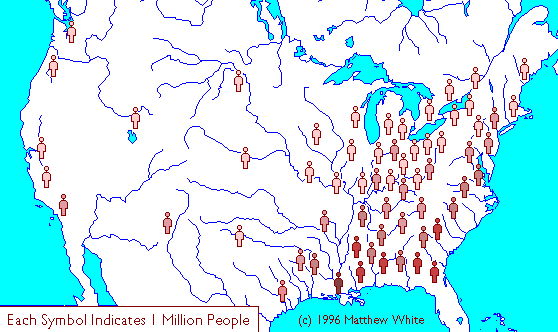
Population and Race
The population of what had once been the United States and Canada is now 61 million -- only a fifth of what it had been at the end of the 20th Century. The bulk of them (51 million) live east of the Missisippi, scraping a meager living as farmers. Overall, there are approximately 65 people per square mile in the eastern heartland, roughly the same density as medieval China and Europe.
During the Industrial Age, the average American belonged to a distinct race native to a particular (usually alien) continent, and society was fractured by these racial distinctions; however, after nine-hundred years of gradual interbreeding, the distinctions between European-American and African-American have gotten extremely blurred. In general, extreme racial characteristics, such as blond hair or brown skin, have disappeared in favor of middle ranges. Skin color comes in various shades of tan, and hair in various shades of brown.
There is, however, a definite north-south gradient of racial types in the East. Around the Great Lakes, where the overwhelming majority of the original gene pool was European (with small, digestible enclaves of urban Africans, Asians and Amerinds), medieval Americans are virtually indistinguishable from their European cousins. As we move south, skin darkens and hair coarsens gradually, until we find a population on the Gulf Coast which is clearly African in origin. (although not entirely. Approximately half the gene pool here originated in Europe.)
Other continents have not contributed heavily to the American gene pool, but the Industrial Era population of the Pacific coast included a substantial Asian minority, which has left a noticeable (although not overwhelming) mark on the facial features of the medieval population here. The tendency toward Asian eyes has been reinforced in the Southwest, where a substantial Mexican population (often of Native American ancestry) existed at one time, which also explains the slight darkeness of the inhabitants here. In the central plains, however, the population is almost entirely European.
Immigration to Medieval America has been slight, and the only substantial contribution from outsiders has been along the Gulf of Mexico, where contact with the Caribbean islanders has given a little boost to the African ancestry of the natives (and conversely, a boost to the European ancestry of the islanders).
The simple clinical fact that most Americans have roots in several continents does not mean that it was a peaceful process. Rape and prostitution have blended the races almost as often as marriage has. When civilization collapsed, and the population plummetted to a fifth of its original peak, oppressed racial minorities found it difficult to avoid being among the unlucky four fifths who didn't make it. Within a few generations, they had been entirely assimilated, expelled or exterminated by the dominant European populations of the North and West.
Only in the South, where the races were in closer equilibrium, did the old racial divisions survive the early centuries. In terms of socioeconomic status, this put blacks on the bottom, and whites, well, also on the bottom. I mean, we're talking about the Middle Ages here, and just about everyone was on the bottom; however, because the law forbade blacks from owning land or working at any important profession, the handful of people at the top were definitely and exclusively white.
The blending of the Southern races occured below the historical horizon, among the poorly recorded underclasses and without the legal sanction of marriage, but by the 25th Century, the process seems to have turned the corner. It's about this time that Northern travellers begin to note the darkness of white Southerners, and Caribbean travellers begin to to note the lightness of black Americans. The differences had become so subtle that only those born and raised in the community could spot them.
The legal watershed came in the early 26th Century, when Jimmy Duval rose to the office of Colonel of the Red River Territory. Throughout Medieval history, bastard sons and usurping soldiers of common birth had often disrupted dynastic succession, but Duval (illegitimate son of the former Colonel) was the first to openly acknowledge his African ancestry. Thirty years later, Ted Flannagan, a mixed-race captain of mercenaries, led a coup which placed him in the Presidency of Georgia. By the end of the century, the nations of the south had redefined their racial divisions. Rather than continuing to classify anyone with black blood as black, they reclassified anyone with white blood as white. As this, by now, included just about everyone, the days of slaughtering people simply for the color of their skin were over, and blacks and whites joined in harmonious brotherhood to slaughter people for the language they spoke or the god they worshipped instead.
| General Topics |
|---|
| Source |
|---|
| Population |
[Tips]
Last Updated July 1999
Copyright © 1999-2003 Matthew White
